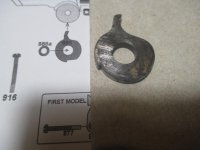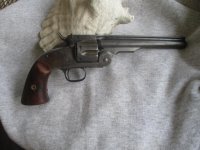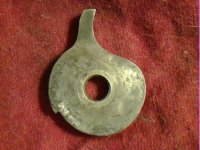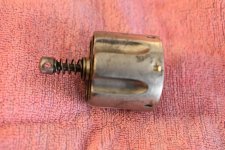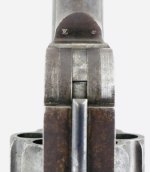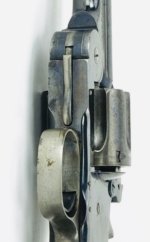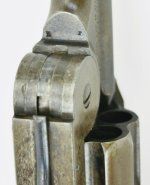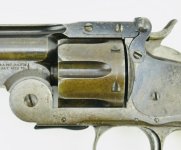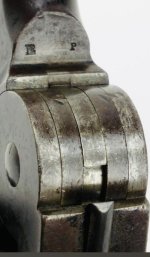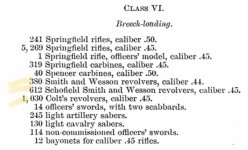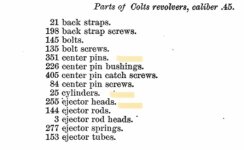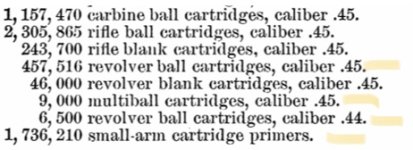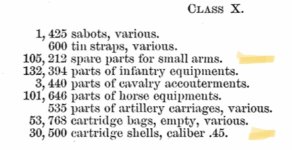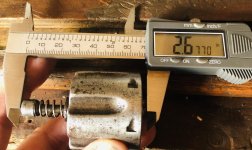Got home from gun show with my "find". First model Schofield in what some would call "relic" condition. The relationships between the hammer, hand, trigger & cylinder stop were excellent. Have some empty 45 S&W (Schofield) brass. Primed them. Got "bang" times 6. Amazed with beautiful bore & chambers. Extraction is an entirely different matter. Removed cylinder. Removed extractor stud. Star fell off. Questioned that as my book "Smith & Wesson Sixguns of the Old West", complete with diagrams does not indicate that the star is a separate part from the grooved extractor. Anyhow, removed the assembly from the front. First problem. Spring came out in pieces. Okay, that can be dealt with. I had already noticed that when I tilt the barrel assembly down, that the empty brass only withdraws maybe half an inch, if that & then fails to snap back. Removed barrel to discover that the cam fails to engage the extractor pawl until the barrel has too little travel to pull the empty brass clear. Upon examination of the cam from the gun & the cam in the book, I find troubling differences. With the "ears?" both oriented up, I see totally different positions of the notches plus a "flat" on the bottom of the cam in the book. My serial # is 739. I'm wondering if there was an engineering change or do I have an incorrect cam or??? Bottom line is that this cam will never engage with the pawl in time to clear the brass. Opinions welcome!
You are using an out of date browser. It may not display this or other websites correctly.
You should upgrade or use an alternative browser.
You should upgrade or use an alternative browser.
First model Schofield extraction issue
- Thread starter Old Dave
- Start date
Register to hide this ad
- Joined
- Dec 1, 2022
- Messages
- 882
- Reaction score
- 1,424
Hi There,
I don't have a 1st model Schofield but I do have a couple 2nd
models. I don't know if there are any differences between the
first and second models' extractor paws but I don't think so.
I took a pic of the extractor paw from my 2nd model. Take a
look at the pic and compare it to yours. They look pretty much
the same (to me).
Cheers!
Webb
I don't have a 1st model Schofield but I do have a couple 2nd
models. I don't know if there are any differences between the
first and second models' extractor paws but I don't think so.
I took a pic of the extractor paw from my 2nd model. Take a
look at the pic and compare it to yours. They look pretty much
the same (to me).
Cheers!
Webb
Attachments
mmaher94087
Member
Old Dave, your photo of the extractor cam shows that the cam is missing the center bushing. The cam and bushing are the same between 1st and 2nd Model Schofields. Webb's photo shows the bushing.
I can't thank Webb enough for that photo! It substantiates what David Chicoine says in his book in that the cam is the same in both models. Then WHY are we seeing something completely different in the book? Does a "can of worms" come to mind? Chicoine is a recognized & respected authority on these things.
NEWS FLASH! I finally got smart enough to take a peek at the GI (Guns International) site & found photos of the bottom including the hinge area of 3 different Schofields. The notch is at the 6 o'clock position on all 3! Mine is obviously NOT. It would appear that the book is correct & a part has been switched in mine!
Another angle. The notch in my cam is not at 6 o'clock & neither is Webb's. If my assumption is correct, his gun is functioning as it should. I now know of 3 where the notch is at 6 o'clock, just like the book. Is there an engineering change involved here? HMM!
mmaher94087
Member
Old Dave, I don't have the Schofield in hand to look at, but I can guess. I'm thinking that the cam is correct, but the extractor base (the round piece the cam pushes) is not correct. It is too short and does not touch the cam when the extractor is fully down in the cylinder.
To test my theory, close the revolver and see if the cam can move. With the cam notch at 6 o'clock, push on the notch with a popsicle stick and see if the cam moves to 8-9 o'clock. Movement indicates the extractor bas is incorrect for your revolver. Your comments in your first post lead me to think the extractor has been messed with.
To test my theory, close the revolver and see if the cam can move. With the cam notch at 6 o'clock, push on the notch with a popsicle stick and see if the cam moves to 8-9 o'clock. Movement indicates the extractor bas is incorrect for your revolver. Your comments in your first post lead me to think the extractor has been messed with.
- Joined
- Dec 1, 2022
- Messages
- 882
- Reaction score
- 1,424
Hi There,
I've been thinking along the same lines as Mike. So, I removed
the cylinder and took a pic. The stem of the extractor protrudes
1-3/32" from the face of the cylinder.
I haven't read anything about any changes to the extractor
mechanism between the 1st and 2nd models but I wish had
a 1st model to compare.
Cheers!
Webb
I've been thinking along the same lines as Mike. So, I removed
the cylinder and took a pic. The stem of the extractor protrudes
1-3/32" from the face of the cylinder.
I haven't read anything about any changes to the extractor
mechanism between the 1st and 2nd models but I wish had
a 1st model to compare.
Cheers!
Webb
Attachments
Last edited:
Cam improvement
Nice Schofield.
Photos 1-3 are the Model 1 Schofield
Photos 4-5 are the Model 2 Schofield
You will note the basically identical position of the cam catch on both models with a slightly longer latch on the model one( shorter travel but high stress).
However, as is listed in the gunsmith book the model 1 cam had a weakness to the design that caused breakage as noted in military re-order parts records. Lots of replacement cams ordered prior to the introduction of the Model 2 Schofield improvements.
The result was a redesign thicker at the base of the nub and ultimately strengthened cam. You have the improved model 2 cam.
Finding an original model 1 cam would be extremely difficult. You'd be better off fabricating one from a tempered steel plate.
Not really difficult.
Another possible solution would be to add length to the ejector rod. You could find the length by temp gluing and extension and adjusting it until it functions correctly then make a permanent repair by adding metal.
So it's possible that your ejector length is too short from damage or the wrong part. Please provide the overall length measurement from ratchet teeth to the end of the plunger. That could also be the problem.
Murph
Nice Schofield.
Photos 1-3 are the Model 1 Schofield
Photos 4-5 are the Model 2 Schofield
You will note the basically identical position of the cam catch on both models with a slightly longer latch on the model one( shorter travel but high stress).
However, as is listed in the gunsmith book the model 1 cam had a weakness to the design that caused breakage as noted in military re-order parts records. Lots of replacement cams ordered prior to the introduction of the Model 2 Schofield improvements.
The result was a redesign thicker at the base of the nub and ultimately strengthened cam. You have the improved model 2 cam.
Finding an original model 1 cam would be extremely difficult. You'd be better off fabricating one from a tempered steel plate.
Not really difficult.
Another possible solution would be to add length to the ejector rod. You could find the length by temp gluing and extension and adjusting it until it functions correctly then make a permanent repair by adding metal.
So it's possible that your ejector length is too short from damage or the wrong part. Please provide the overall length measurement from ratchet teeth to the end of the plunger. That could also be the problem.
Murph
Attachments
Last edited:
Update. Been busy with Files & superglue all day. Yesterday I received from Taylors, a new cam, extractor rod & spring. The new rod & the one that I removed from the gun are exactly the same length however the Uberti rod, being machined differently at the front, does a better job of controlling the spring. The Uberti cam, when laid on top of the one removed from the gun, is exactly the same except for the hole, as Uberti uses no bushing. Fortunately, I found a bit that turned out to be perfect for enlarging the hole & the bushing was a perfect fit. Not wanting to alter the cam from the gun, I fabricated & bent a strap to conform to the curvature of the cam & cut the strap to cause the extractor pawl to engage at about 6:30 position. Bad result. The instant that the pawl engaged the "new" notch, everything stopped. Tomorrow, I open her up again, remove the cylinder & take a measurement (front to back) of the cylinder & rod together. I'm also considering reshaping the bottom of the Uberti cam (removing my strap) & cutting a new notch between 6 & 7 o'clock. More pics tomorrow. THANKS to everyone!
Today. Measured distance from teeth (in star of extractor) to end of ejector rod & I come up with 2.677 in. From front of cylinder to end of extractor rod is 1 inch. From front of cylinder (excluding the collar on the front) I get 1.145 or 1 1/8th inch. Ordered a replacement extractor from Popperts. Other than that, no progress.
- Joined
- Dec 22, 2002
- Messages
- 742
- Reaction score
- 1,283
Old Dave, did you happen to buy that Schofield at the Lakeland, Florida, gun show a week ago? There was one for sale that I was going to show a friend, but it was sold before he had a chance to look at it. I did not recognize the seller.
Yes. When I first saw it, the cylinder was binding up against the latch, failing to go anywhere. We both knew that there was going to be a problem. He reduced the price by a third & since I'd made a good sale, I could justify it. Since then, I have perfect performance as to timing & lockup, firing blanks, receiving excellent contact from firing pin to primers. The remaining issue is the extraction problem. I'm informed in this forum that my cam is from the 2nd model. Chicione's book shows 3 different cams for same gun. He also mentions that the extractor rods are different between first & second models but does not say by how much. The Uberti spring was a big help. I have a replacement extractor on the way as it appears that the star in mine has a problem. When I remove the stud from the center, the star falls off & that is not supposed to happen. I would like to see a cam & extractor rod from a functional first model, but so far that has not happened. Oh well. It gives me something to do.
On an entirely different note, are the grips. Normally when I see non-factory grips, they are from Ebay or whatever. They would be there because of damage to or loss of originals. These are both from a 2nd model Schofield, as the right panel has an unreadable cartouche and a serial #on the inside of that panel that is in the 2nd model range. The left panel has an extremely worn 1877 date above another very weak cartouche, being common to only the 2nd model. Bottom line is that it appears that the originals from this gun, were replaced with originals from a 2nd model. A mystery that I can't help but wonder if it was done by an armorer, back in the day.
Parts swap
That's very possible Dave.
Military records list yearly replacement parts orders so replacing parts was common with service revolvers both Colt, Schofield, and 44 American due to continuous field damage. So grips for sure.
There was a war on so the guns were being used and shot a lot. Primarily with field reloads.
I'll post some more parts photos later today. Records photos also.
The Schofield has a very rich history.
You're very fortunate to have found a model 1 with the original barrel length. Almost 70% went to Government Surplus sales and most sold to American Express and Wells Fargo in two large contracts.
You can see during the year 1877 the Government was dealing with both the Indian wars and the Railroad Riots from coast to coast at the same time. The Military records reflect huge numbers of ammo, primers for reloading issued and damage to firearms/spare parts ordered.
Those guns issued to the Militia alone in 1877 included significant numbers of Schofield and 44 American revolvers. They also issued multi-ball ammo to the Militia that same year.
1.7 million small arms primers in 1 year alone! That's a lot of reloading!!
105,000 spare parts for small arms! That's a lot of repairs!!
Murph
That's very possible Dave.
Military records list yearly replacement parts orders so replacing parts was common with service revolvers both Colt, Schofield, and 44 American due to continuous field damage. So grips for sure.
There was a war on so the guns were being used and shot a lot. Primarily with field reloads.
I'll post some more parts photos later today. Records photos also.
The Schofield has a very rich history.
You're very fortunate to have found a model 1 with the original barrel length. Almost 70% went to Government Surplus sales and most sold to American Express and Wells Fargo in two large contracts.
You can see during the year 1877 the Government was dealing with both the Indian wars and the Railroad Riots from coast to coast at the same time. The Military records reflect huge numbers of ammo, primers for reloading issued and damage to firearms/spare parts ordered.
Those guns issued to the Militia alone in 1877 included significant numbers of Schofield and 44 American revolvers. They also issued multi-ball ammo to the Militia that same year.
1.7 million small arms primers in 1 year alone! That's a lot of reloading!!
105,000 spare parts for small arms! That's a lot of repairs!!
Murph
Attachments
Last edited:
- Joined
- Dec 22, 2002
- Messages
- 742
- Reaction score
- 1,283
The Fifth Edition of the Standard Catalog lists the worth of he First Model as $1,550 for "Poor", and $2,500 for "Fair." Since the seller's asking price for that gun was ridiculous, when he reduced it by 1/3; then, you made a good buy.
If you give up trying to do it yourself, I know a good, honest, reasonably priced gunsmith in Brandon who specializes in Smith & Wesson revolvers and he is a certified Smith & Wesson armorer in pistol and revolver He has made several of my old guns work again--2-3 from the Civil War (which I used to collect) and a couple of late 1800's.
Good luck with your project!
If you give up trying to do it yourself, I know a good, honest, reasonably priced gunsmith in Brandon who specializes in Smith & Wesson revolvers and he is a certified Smith & Wesson armorer in pistol and revolver He has made several of my old guns work again--2-3 from the Civil War (which I used to collect) and a couple of late 1800's.
Good luck with your project!
Correct measurement
Sorry Dave,
I missed your post with measurements.
Ok, take a look at my photo attached.
That's a late 2nd model Schofield cylinder/plunger/ratchet.
Notice it measures exactly what you posted from your Model 1?
That's because your Army issued Schofield Model 1 broke in action and made it back to the Armory to receive an updated Model 2 ratchet/plunger/cam replacement. So it was used heavily during the War, broke, and was properly fixed at the armory.
So it should actually work well enough with some help.
Why isn't it working?
Ok, it was also used a lot during the war after the upgrade and likely developed excessive wear in the key slot for the ratchet, inside wear from the plunger going up and down ejecting dirty black powder shells in battle, spring rubbing against the inner base pin, etc etc etc. so it's sloppy.
Ok, so let's test it correctly to make sure it's not bent first. That being the stem/plunger from ejecting thousands of dirty black powder rounds in a panic during battle.
So what you should do is rotate the cylinder by hand from one chamber to the next after installing the original model 2 cam well greased. See if the ejector will function on any chamber. It's also a good idea to install empty cases first in all the cylinder chambers. We do this to steady the ratchet that often is very worn from use and won't stay centered to each chamber. This condition can also cause jamming of the ejector.
Let me know what the results are. It should work loaded with empty shells.
Murph
Sorry Dave,
I missed your post with measurements.
Ok, take a look at my photo attached.
That's a late 2nd model Schofield cylinder/plunger/ratchet.
Notice it measures exactly what you posted from your Model 1?
That's because your Army issued Schofield Model 1 broke in action and made it back to the Armory to receive an updated Model 2 ratchet/plunger/cam replacement. So it was used heavily during the War, broke, and was properly fixed at the armory.
So it should actually work well enough with some help.
Why isn't it working?
Ok, it was also used a lot during the war after the upgrade and likely developed excessive wear in the key slot for the ratchet, inside wear from the plunger going up and down ejecting dirty black powder shells in battle, spring rubbing against the inner base pin, etc etc etc. so it's sloppy.
Ok, so let's test it correctly to make sure it's not bent first. That being the stem/plunger from ejecting thousands of dirty black powder rounds in a panic during battle.
So what you should do is rotate the cylinder by hand from one chamber to the next after installing the original model 2 cam well greased. See if the ejector will function on any chamber. It's also a good idea to install empty cases first in all the cylinder chambers. We do this to steady the ratchet that often is very worn from use and won't stay centered to each chamber. This condition can also cause jamming of the ejector.
Let me know what the results are. It should work loaded with empty shells.
Murph
Attachments
Similar threads
- Replies
- 7
- Views
- 829
- Replies
- 44
- Views
- 2K
- Replies
- 5
- Views
- 506

